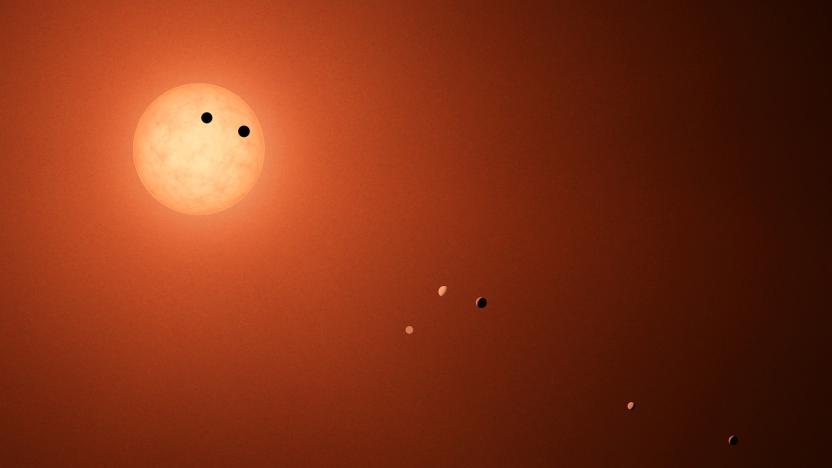formation
Latest

Bowers & Wilkins' Formation Flex is a pricey HomePod alternative
Bowers & Wilkins has finally built a competitor to Apple's Homepod. Well, almost. Today, the company -- best known for its luxurious Nautilus and 800 Series Diamond hardware -- announced the Flex, a smaller speaker that sits alongside its existing line of Formation wireless products. The device can be used independently, as a pair, or with any existing Formation speaker, including its TV-focused soundbar and cylindrical subwoofer. It uses the same tweeter "technology" found in its 600 series speakers and, the company claims, delivers "the highest quality sound ever found in a standalone wireless speaker of its size." That's some serious fighting talk!

Astronomers believe the young Milky Way once swallowed a dwarf galaxy
Astronomers believe they've mapped an important sequence of events that shaped our galaxy 10 billion years ago. In a paper published in Nature Astronomy today, researchers from the Instituto de Astrofisica de Canarias (IAC) share their findings that a dwarf galaxy, Gaia-Enceladus, once collided and merged with the early Milky Way. Their discovery offers a new understanding of how the Milky Way formed.

Scientists think some supermassive black holes didn’t start as stars
Despite the fact that scientists now have a real image of a supermassive black hole, they still have plenty of questions about the objects. Now, astrophysicists at Western University may have a new explanation for how some black holes formed. In research published in The Astrophysical Journal Letters today, Shantanu Basu and Arpan Das suggest that not all black holes emerge from star remnants. Their model may help scientists explain the formation of extremely massive black holes at a very early stage of the universe's development.

Bowers & Wilkins is betting big on high-end, multi-room streaming
For Andy Kerr, product communication director at Bowers & Wilkins, Formation has been a long time coming. "We're following a path that we've wanted to be on for... probably since the start. Since the inception of the company."

Bowers & Wilkins unveils wireless Formation speaker family
Bowers & Wilkins, best known for its luxurious Nautilus and 800 Series Diamond speakers, is launching a wireless audio system called Formation. The company is starting with a soundbar, two bookshelf-style speakers, a cheaper single speaker, a standalone subwoofer and an audio box that gives older devices streaming capabilities. All five pieces will work separately or in tandem for a multi-room experience similar to Sonos.

Trappist-1 planets may have formed from chunks of melting ice
After its discovery, Trappist-1 instantly became one of the most interesting stars in the Milky Way, with seven Earth-sized planets including three in the life-supporting "habitable zone." But, why did the planets form in such uniform Earth-like sizes so close to their star? Astronomers from the University of Amsterdam believe everything can be explained by small chunks of ice that clustered in the region where water just starts to freeze. Eventually, enough chunks clotted together like plasticine, forming worlds just inside the "ice zone" -- the perfect spot for life.

Exoplanets may have carved dusty tracks around a young star
Astronomers have spotted what they believe are two Saturn-sized planets carving "tracks" through a young star's protoplanetary disk. Although scientists have found plenty of exoplanets ranging from gas giants like Jupiter to rocky, Earth-like worlds, most orbit mature stars. However, the not-yet-fully-formed worlds imaged by the ALMA telescope array show that stars can possibly spawn planets at an earlier age than previously thought.

MIT researchers locate genes that help underlie memory formation, zap some mice
Over time, the neurons in your brain are going to change. And that's only natural. When you experience a new event, your brain encodes the memory by altering the connections between neurons, which is caused by turning on several genes within these neurons. Recenty, a team of neuroscientists at MIT published their findings in the Dec. 23rd issue of Science in which the group was able to pinpoint some of the exact locations of memory formation within the brain. The team, led by Yingxi Lin, found that the Npas4 gene is especially active in the hippocampus, a brain structure known to be critical in forming long-term memories. Once engaged, the Npas4 gene turns on a series of other genes that modify the brain's internal wiring by adjusting the strength of synapses, or connections between neurons. The findings were obtained by studying the neural activity of mice which underwent mild electric shocks when they entered a specific chamber. Upon receiving the shock, researchers noted that Npas4 is turned on very early during this conditioning. The research is still in its early stages and while the researchers have identified only a few of the genes regulated by Npas4, they suspect there could be hundreds more that help with the memory formation process. The lesson learned: stick to it and if you have any questions, mildly shock some mice.

GRASP Lab quadrocopters learn to follow the leader and fly in formation
The University of Pennsylvania's GRASP Lab has already recklessly taught its autonomous quadrocopters to move in packs, fly through hoops and build things on their own, and it's now for some reason decided to teach them yet another trick they'll surely use against us one day. As you can see in the video above, the quadrocopters are now able to take cues from a leader and fly in formation. What's more, they can even continue with the formation if one loses communication and falls out of the pack, which the researchers note is key to the success of any swarm. Isn't that reassuring?

iPhone game devs give us their thoughts on the iPad
With yesterday's announcement from Apple of its much hyped "latest creation" -- the iPad -- and the news that already existing iPhone applications (that means games too, folks) will be playable on the device, we started wondering how the developers of the world felt about this shiny new piece of gadgetry. So we asked a handful of our favorites -- Canabalt's Adam "Atomic" Saltsman, Pocket God's Dave Castelnuovo, and PopCap's Andrew Stein, just to namedrop a few -- to give us their reactions. "It's hard to say anything concrete without actually playing with the thing personally, but I'm optimistic about it continuing to open up video games to even more 'normal' people," Saltsman told us. "I'm hopeful that having a big multitouch space will help mediate the whole 'fat fingers on a tiny screen' problem." PopCap's Andrew Stein agreed, telling us "We'll certainly look at the unique capabilities of the iPad and work hard to utilize those in instances where they can make our games even more fun." Republic of Fun prez Mike Rasmussen sees things a bit differently, noting the opportunity in the upped horsepower of the device. "From a pure gaming perspective, I'm excited about the additional resolution and horsepower, and really interested to start understanding the 3D performance of the A4 [chip]." But even the most successful app developer on the market -- Pocket God creator Dave Castelnuovo -- seems a bit reticent of the iPad, telling us he sees "a lot of potential with the device," but his company is going to "wait to see what kind of acceptance the tablet will have" before moving forward with development. But that's not all! See the full reactions from a variety of iPhone game developers after the break. %Gallery-84102%

Collision detection in WAR's PvP
I hadn't heard that WAR would have collision detection (it must be in the whole game, right? can't only be in PvP, can it?), but Hardcore Casual did, and just like him, I'm very interested in the possibilities. He cites it as a problem of premades and PuGs-- premades will know much better how to deal with line-of-sight and positioning and formation problems, while PuGs will trip over themselves trying to get past someone else. Me, I see it more as a problem of pranks and griefing. In World of Warcraft, where Blizzard hasn't implemented collision detection, they're already having issues-- giving players the ability to block space in large numbers just opens up a whole world of griefing.But as HC says, it's all in the implementation-- it may be that some things need line-of-sight, while others (spells and such) don't, and any blockage depends on just where the hitboxes are-- if characters can sneak past each other, or are able to push each other out of the way, then that would change any plans.It'll be interesting to see how it all pans out, however. Collision detection is a minefield for developers, but can definitely lend itself to new types of gameplay. While most MMOs have avoided the issue entirely, we'll have to see if WAR is willing to hit the issue (so to speak) head-on.





